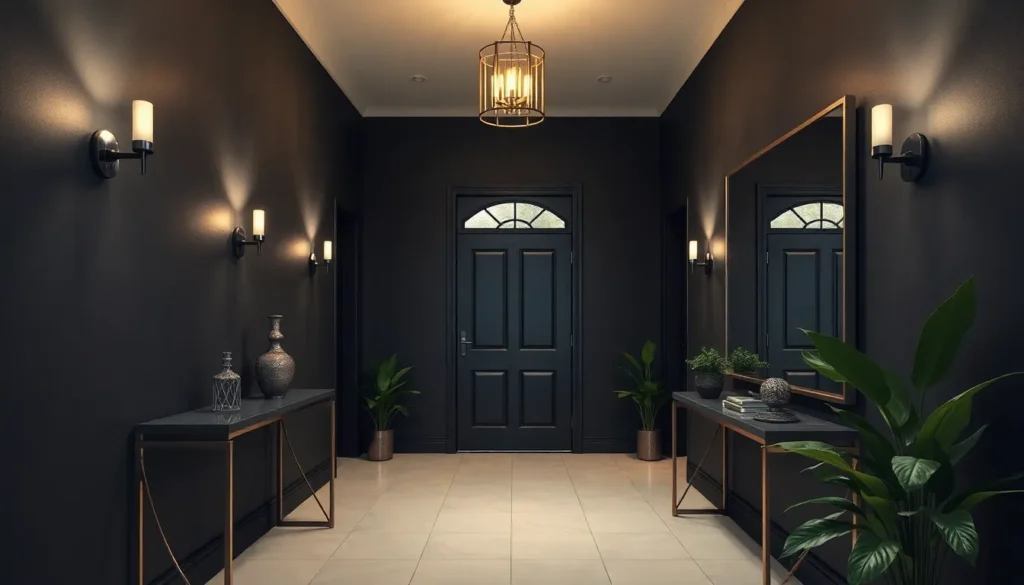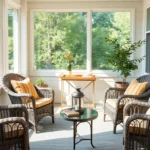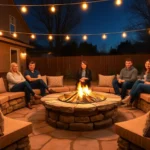Dark hallways often feel like forgotten spaces in our homes – those transitional areas that connect rooms but rarely receive the design attention they deserve. We’ve all experienced that awkward moment when guests navigate through a dimly lit corridor that feels more like a cave than a welcoming passage.
The good news? Dark hallways present incredible opportunities for creative transformation. Rather than fighting against the shadows we can embrace them and turn these spaces into stunning design statements. From strategic lighting answers to bold color choices that actually enhance the darkness these overlooked areas can become some of the most dramatic and memorable parts of your home.
Whether you’re dealing with a narrow corridor or a spacious gallery-style hallway we’ll show you how to work with low light conditions to create something truly spectacular. It’s time to stop seeing darkness as a limitation and start viewing it as your secret weapon for sophisticated interior design.
Embrace Bold Dark Paint Colors for Maximum Impact
Bold dark paint colors transform ordinary hallways into sophisticated design statements that command attention. We’ve discovered that strategic color choices can completely redefine how guests perceive these transitional spaces.
Charcoal Gray for Sophisticated Elegance
Charcoal gray creates an instant foundation of refined sophistication in any hallway setting. This versatile shade works exceptionally well with both warm and cool accent colors, allowing us to layer textures and artwork without overwhelming the space. We recommend pairing charcoal walls with crisp white trim to create striking architectural definition that draws the eye down the corridor.
Consider using charcoal gray in matte or eggshell finishes to minimize light reflection while maintaining visual depth. The color serves as an elegant backdrop for gallery walls, metallic fixtures, and natural wood elements. We’ve found that charcoal gray hallways feel more spacious than expected because the color recedes naturally, creating an illusion of expanded width.
Deep Navy Blue for Timeless Appeal
Deep navy blue delivers classic elegance that never goes out of style in hallway design. This rich hue evokes the feeling of luxury while remaining surprisingly versatile for various decorating styles. We love how navy blue complements brass hardware, white wainscoting, and vintage lighting fixtures to create a truly sophisticated atmosphere.
Navy works particularly well in hallways with natural light sources because it maintains its depth without appearing flat or lifeless. The color pairs beautifully with cream moldings and natural fiber runners to soften the overall look. We suggest testing navy samples in different lighting conditions throughout the day to ensure the shade maintains its intended richness.
Rich Black for Dramatic Statement Walls
Rich black paint creates the ultimate dramatic impact in hallway spaces that demand attention. This bold choice works best when balanced with strategic lighting and carefully selected accent pieces that prevent the space from feeling cave like. We recommend using black in hallways with interesting architectural features like exposed beams, arched doorways, or decorative moldings.
Black walls showcase artwork, mirrors, and metallic accents with incredible effectiveness because they provide maximum contrast. The key lies in incorporating multiple light sources including sconces, pendant lights, and table lamps to create depth and visual interest. We’ve seen black hallways become the most memorable spaces in entire homes when executed with confidence and proper lighting design.
Install Strategic Lighting to Enhance Dark Spaces
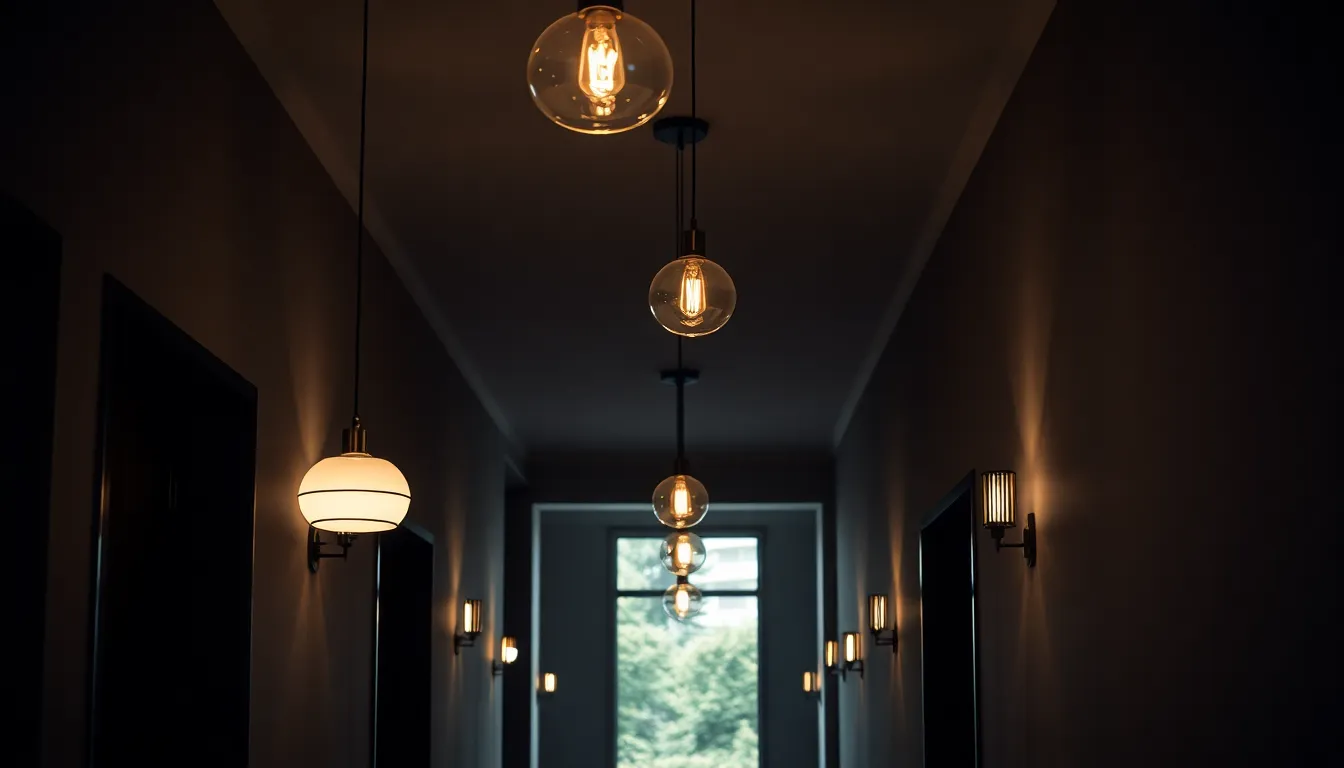
Strategic lighting transforms dark hallways from forgotten spaces into stunning design features. We’ll explore three powerful lighting answers that maximize both functionality and style in these challenging areas.
Pendant Lights for Focused Illumination
Double or grouped pendant lights create striking focal points while delivering maximum overhead light coverage in dark hallways. We recommend these fixtures particularly for areas with high ceilings where their dramatic impact can truly shine.
Delicate pendant silhouettes work best in narrow hallways to avoid overwhelming the limited space. The key lies in selecting fixtures that provide focused illumination without creating visual clutter.
Grouped arrangements multiply the lighting effect while adding architectural interest to otherwise plain ceiling areas. This approach ensures even light distribution across longer hallway spans.
Wall Sconces for Ambient Lighting
Wall sconces deliver soft ambient illumination that’s increasingly popular for hallway applications. We position these fixtures strategically near mirrors or artwork to draw attention and enhance the overall visual experience.
Minimalist and long hallways benefit most from wall sconce placement as they provide gentle lighting without competing for ceiling space. The ambient glow creates warmth and invitation in previously unwelcoming areas.
Pairing sconces with accent pieces creates a cohesive design approach that elevates the entire hallway aesthetic. This combination works especially well when sconces frame doorways or highlight architectural details.
LED Strip Lighting for Modern Accent Effects
LED strip lighting offers unmatched flexibility with its contemporary aesthetic that adapts to various hallway configurations. We install these versatile strips along baseboards, under handrails, or within architectural features for subtle accent effects.
Floor illumination becomes both a safety feature and style element when LED strips highlight the walking path. This approach creates visual interest while ensuring secure navigation through darker areas.
Modern accent lighting through LED strips transforms ordinary hallway features into design statements. The customizable nature of these fixtures allows for color changes and scheduling options that adapt to different times of day.
Choose Light-Colored Flooring to Balance Darkness

Light flooring creates the perfect counterpoint to dark hallway walls and ceilings. We’ve found that strategic flooring choices can dramatically amplify available light while maintaining the sophisticated ambiance you’ve created.
White or Cream Tiles for High Contrast
White tiles deliver maximum light reflection to brighten your darkest hallways instantly. These high contrast surfaces bounce natural and artificial light throughout the space, creating visual balance against deep wall colors. Cream tiles offer a softer alternative while still providing excellent light amplification properties.
Large format tiles work exceptionally well in narrow hallways since they minimize grout lines and create seamless light reflection. We recommend glossy or semi gloss finishes to maximize the light bouncing effect. Porcelain tiles in white or cream tones provide durability alongside their brightening capabilities.
Light Hardwood for Warm Undertones
Light hardwood floors bring warmth to dark hallways without sacrificing brightness. Oak, maple, and ash varieties in natural or whitewashed finishes create cozy atmospheres while reflecting light upward. These warm undertones prevent dark spaces from feeling cold or unwelcoming.
Wide plank hardwood enhances the sense of space in narrow hallways through fewer seam lines. We’ve seen excellent results with light hickory and birch that maintain their natural grain patterns. Nordic inspired painted wood floors offer another option for achieving that brighter, airier feel in traditionally dark spaces.
Pale Stone for Natural Texture
Pale stone flooring adds sophisticated texture while improving light reflection throughout dark hallways. Limestone, travertine, and light marble varieties provide natural beauty alongside their brightening properties. These materials create visual interest through subtle variations in tone and pattern.
Honed finishes on pale stone offer slip resistance and minimize maintenance while still reflecting light effectively. We recommend lighter shades of sandstone or granite for high traffic hallways that need durability. Natural stone’s ability to reflect light makes it an excellent choice for balancing darkness with organic elegance.
Add Metallic Accents for Luxurious Touches

Metallic finishes transform dark hallways into glamorous spaces that exude sophistication and luxury. We’ll explore how strategic metallic accents can elevate your hallway’s aesthetic while complementing the rich, moody tones you’ve established.
Gold Hardware for Warm Sophistication
Gold hardware brings instant warmth to dark hallway spaces while maintaining an elegant, luxurious atmosphere. Picture frames with gold leafing create stunning focal points against charcoal walls, while gold door handles and light switch plates add cohesive metallic touches throughout the space.
Warm gold tones work particularly well with deep navy and charcoal color schemes, creating a balanced contrast that feels both inviting and upscale. Cabinet hardware in brushed gold finishes provides subtle sophistication without overwhelming narrow hallway spaces.
Lighting fixtures in gold tones serve dual purposes by illuminating your dark hallway while acting as decorative statement pieces. Pendant lights with gold accents or chandeliers featuring warm metallic elements become instant conversation starters that guests notice immediately.
Silver Fixtures for Cool Contemporary Style
Silver fixtures deliver a crisp, modern aesthetic that perfectly complements cool toned dark hallways. Polished chrome light fixtures create clean lines and reflect existing light sources, maximizing brightness in low light conditions.
Contemporary silver accents work exceptionally well with deep grays and black color palettes, maintaining the sophisticated edge while adding metallic interest. Door hardware in brushed nickel or polished chrome provides a sleek, unified look that enhances your hallway’s modern appeal.
Mirror frames in silver finishes amplify light reflection while serving as functional decorative elements. Wall sconces with silver detailing offer both ambient lighting and architectural interest, creating layers of visual depth in your transformed hallway space.
Brass Elements for Vintage Inspired Charm
Brass elements infuse dark hallways with vintage character and timeless appeal that never goes out of style. Antique brass fixtures create authentic period charm, while modern brass interpretations offer contemporary sophistication with classic undertones.
Vintage inspired brass accessories like decorative hooks, picture frames, and small accent pieces add personality without overwhelming your carefully curated dark aesthetic. These warm metallic touches create inviting focal points that draw the eye and add visual interest to long hallway spaces.
Brass lighting fixtures with exposed bulbs or vintage inspired silhouettes become stunning centerpieces that celebrate both form and function. Wall mounted brass sconces provide targeted illumination while contributing to your hallway’s curated, collected over time appearance.
Incorporate Mirrors to Amplify Light and Space

Mirrors transform dark hallways by reflecting both natural and artificial light throughout the space. We’ll explore three strategic approaches that maximize this reflective power while adding visual appeal.
Large Statement Mirrors for Maximum Reflection
Oversized mirrors placed at hallway endpoints create dramatic focal points while amplifying available light. Positioning a large mirror at the end of your corridor or opposite a window maximizes reflection of both natural and artificial illumination. These statement pieces effectively brighten the entire space while creating the illusion of added length.
Narrow corridors benefit significantly from large format mirrors that serve dual purposes. The reflective surface bounces light throughout the hallway while the substantial size creates a striking visual anchor. We recommend selecting mirrors that span at least two thirds of your wall width for optimal light amplification.
Strategic placement opposite light sources doubles the illumination effect. When you position an oversized mirror directly across from windows or light fixtures, it captures and redistributes that light throughout the dark space. This technique works particularly well in long hallways where natural light struggles to reach the far end.
Gallery Wall of Small Mirrors for Visual Interest
Collections of small mirrors arranged as gallery walls add dynamism while reflecting light from multiple angles. This approach introduces texture and personality to your dark hallway while maintaining the light improving benefits. The varied reflection points create visual movement that draws the eye through the space.
Symmetrical arrangements provide structured elegance in formal hallway settings. We suggest using identical mirror shapes and sizes in grid patterns for a cohesive, sophisticated look. This method works especially well when you want to maintain a clean, organized aesthetic while maximizing light reflection.
Eclectic arrangements offer creative flexibility for personalized hallway design. Mixing different mirror sizes, shapes, and frame styles creates an artistic gallery effect. The varied reflective surfaces still enhance light perception while showcasing your unique decorative style.
Antique Mirrors for Character and Depth
Antique mirrors with aged patina and ornate frames add character while maintaining light improving properties. These pieces provide both functional illumination benefits and decorative appeal through their unique detailing. The reflective surfaces continue to amplify light perception even though their vintage characteristics.
Positioning antique mirrors near light sources maximizes both illumination and visual impact. We recommend placing these decorative pieces adjacent to wall sconces or pendant lights to capture and reflect that illumination. This strategic placement ensures the ornate frames become highlighted features while serving their functional purpose.
Intervals of antique mirrors along lengthy hallways create rhythm and brightness. Spacing these decorative pieces at regular intervals provides consistent light reflection points throughout the corridor. The vintage appeal adds elegance while the strategic positioning ensures even light distribution across the entire hallway length.
Display Artwork That Complements Dark Walls
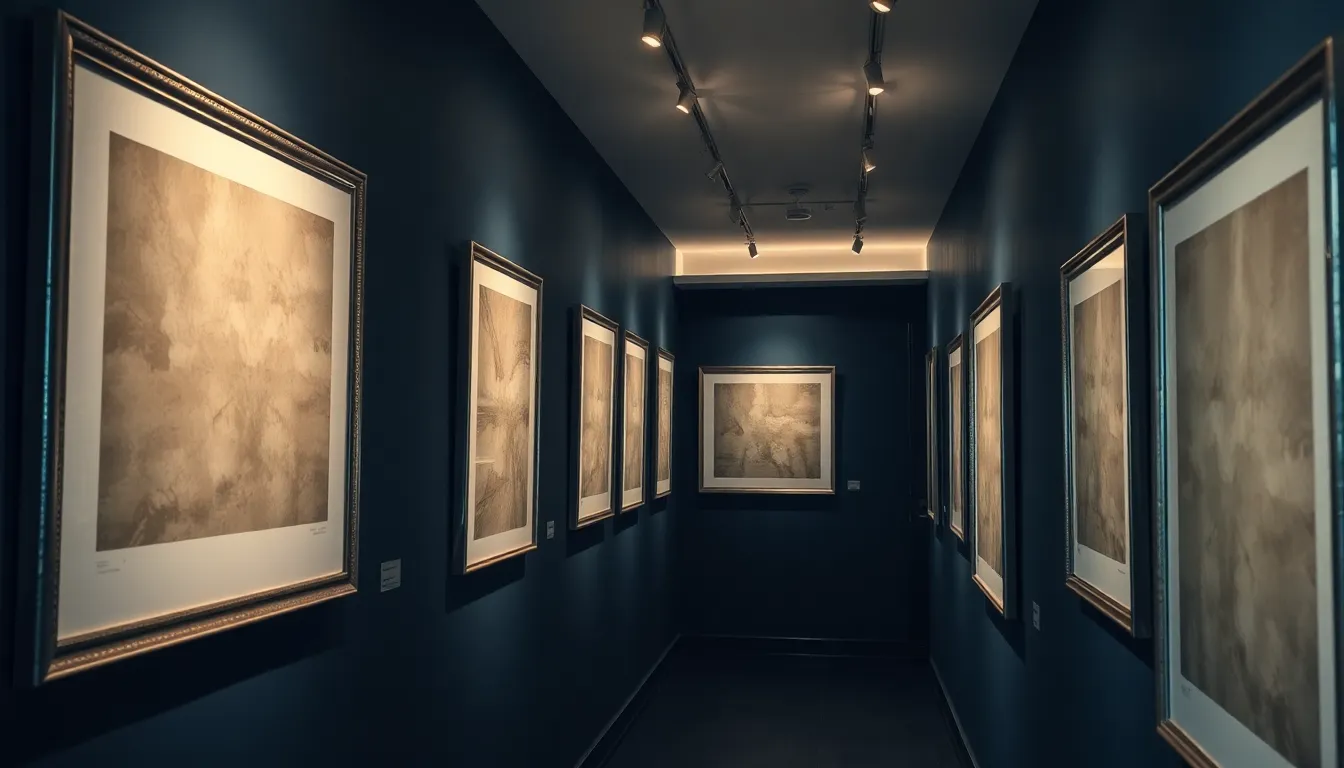
Transforming our dark hallway walls into captivating gallery spaces requires thoughtful artwork selection that works with rather than against the deep tones we’ve embraced.
Light-Colored Paintings for Striking Contrast
Light-colored paintings create stunning visual impact against dark hallway backgrounds by introducing bright focal points that immediately draw the eye. We recommend selecting artwork in neutral tones like whites, creams, and soft pastels to achieve maximum contrast against navy, charcoal, or black walls. These pale compositions stand out vividly and enhance the perception of brightness throughout the space.
Neutral artwork breaks up shadowed wall surfaces while adding sophisticated visual interest to our transformed corridors. White and cream paintings particularly excel at reflecting available light back into the hallway, creating an illusion of expanded space and improved illumination. Soft pastel pieces in pale blues, gentle pinks, or light yellows provide subtle color variation without overwhelming the dramatic dark backdrop we’ve carefully curated.
Metallic Frames for Added Shine
Metallic frames amplify the sophistication of our artwork displays while serving a practical lighting purpose through their reflective properties. Gold frames introduce warm elegance that complements deep wall colors beautifully, creating luxurious focal points that catch and bounce light throughout the hallway. Silver frames offer crisp, modern appeal while maximizing brightness reflection from any available light sources.
Copper frames provide unique warmth and character that enhances vintage or eclectic art collections in our dark spaces. These reflective finishes help distribute illumination more effectively, contributing to an overall feeling of openness even though the bold wall colors. We find that metallic accents create visual continuity when paired with other reflective elements like mirrors or metallic light fixtures throughout our hallway design.
Gallery Lighting to Highlight Pieces
Gallery lighting transforms our artwork displays into professional showcases while providing essential illumination for dark hallway spaces. Wall-mounted picture lights installed above individual pieces create focused beams that highlight exact artworks while casting warm ambient light throughout the corridor. These fixtures serve dual purposes by showcasing our carefully selected pieces and brightening the overall atmosphere.
LED wall sconces positioned strategically along gallery walls provide bright, shadow-free illumination that ensures each artwork receives proper lighting attention. Track lighting systems offer flexibility for highlighting multiple pieces while minimizing shadows that might obscure our displays. Recessed picture lights create clean, streamlined appearances that won’t compete with our artwork for visual attention while delivering the focused illumination necessary to make light-colored paintings pop against dark backgrounds.
Use Textured Wall Treatments for Added Dimension
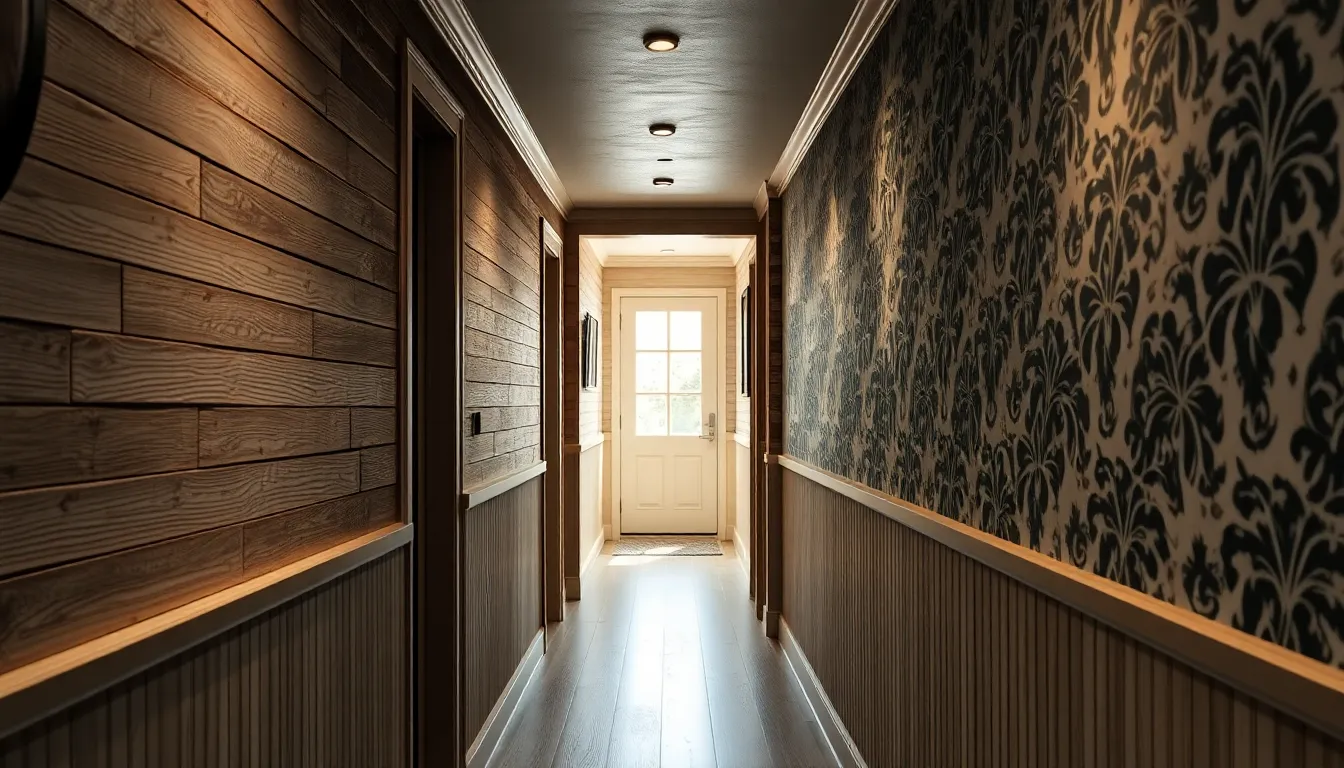
Textured wall treatments transform dark hallways by creating visual depth that catches and reflects light differently than flat surfaces. These dimensional elements help mitigate the cave-like effect common in narrow or dimly lit corridors.
Shiplap for Rustic Character
Shiplap brings rustic, inviting character to dark hallways through its distinctive wooden board construction with overlapped grooves. The horizontal lines naturally elongate spaces visually, drawing your eye along the corridor’s length and making narrow hallways feel more spacious.
We recommend painting shiplap in light tones to brighten dark areas while maintaining its natural wood texture appeal. Alternatively, you can leave it in warm, dark hues to create a cozy, snug atmosphere that embraces the hallway’s low-light conditions. This versatile treatment works particularly well in farmhouse or transitional design schemes.
Wainscoting for Classic Appeal
Wainscoting covers the lower half of hallway walls with traditional paneling, typically featuring a chair rail that separates it from the upper wall section. This classic architectural feature adds sophistication and visual structure to otherwise plain corridor spaces.
Painting wainscoting in light colors helps reflect ambient light upward, brightening the entire hallway naturally. We suggest using darker shades on the upper wall portion to create dramatic contrast and visual interest. This two-tone approach maximizes light reflection while adding depth and character to your dark hallway design.
Textured Wallpaper for Pattern Interest
Textured wallpaper with bold patterns or subtle relief enlivens dark hallways by introducing visual intrigue and dimensional interest. Patterns featuring metallic or light-reflective elements maximize available illumination, making spaces appear larger and less confined.
Dark, moody wallpapers with textural details create striking statement walls, while light-toned textured options help brighten confined areas. We recommend choosing wallpapers with raised surfaces or embossed patterns that create shadow play when light hits them at different angles. This interplay of light and texture adds ever-changing visual movement to static corridor spaces.
Select Furniture That Enhances the Dark Aesthetic
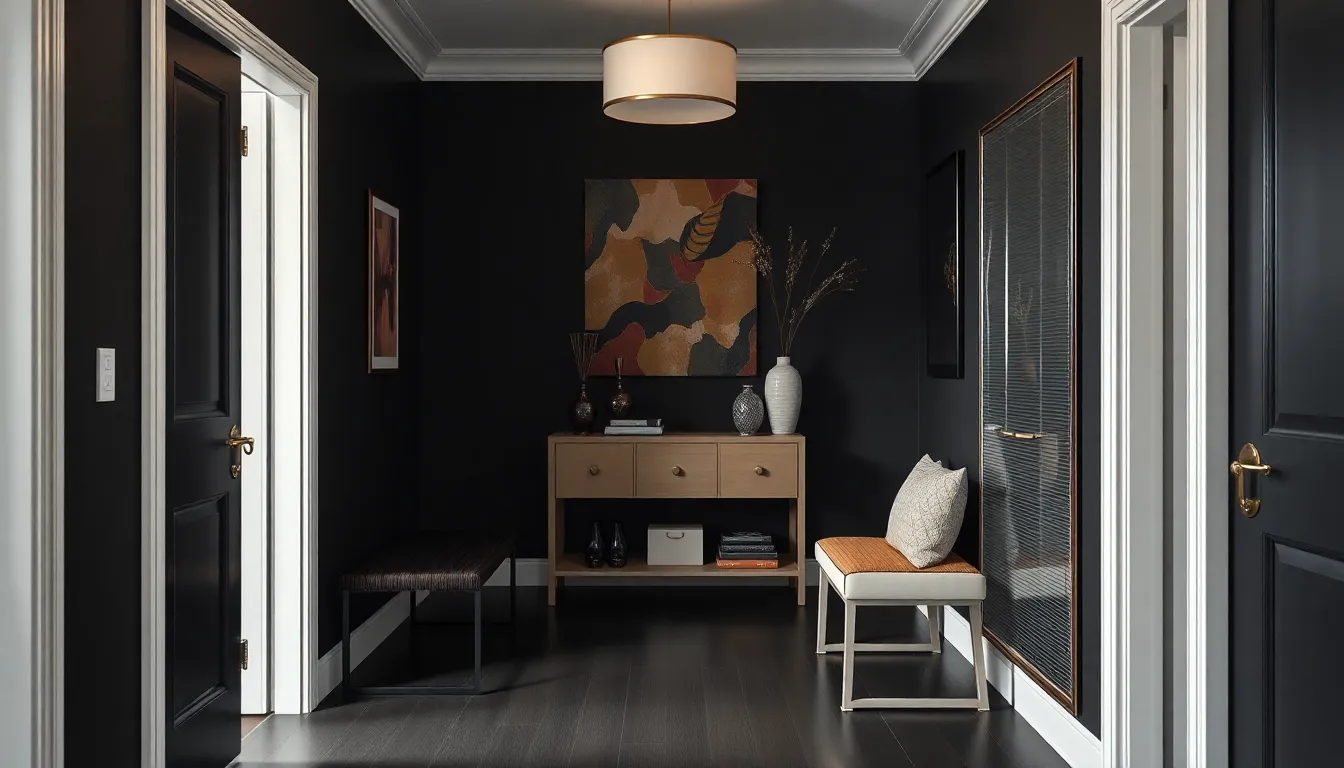
Choosing the right furniture pieces transforms your dark hallway from a neglected passageway into a sophisticated design statement. Strategic furniture selection creates visual balance while maintaining the dramatic ambiance we’ve established with bold colors and strategic lighting.
Light-Colored Console Tables for Balance
Light-colored console tables serve as the perfect counterbalance to dark hallway walls, creating visual contrast that prevents the space from feeling overwhelming. We recommend selecting pieces in crisp white, warm cream, or soft gray finishes that reflect available light and brighten the overall atmosphere. These tables provide essential functionality for displaying decorative objects, storing keys, or showcasing artwork while maintaining the sophisticated aesthetic.
Console tables with glass tops offer additional light reflection, amplifying the brightness in your hallway space. Positioning these pieces beneath mirrors or artwork creates layered lighting effects that enhance the room’s visual depth. We suggest choosing tables with clean lines and minimal ornamentation to maintain the sleek, modern feel that complements dark wall treatments.
Dark Wood Benches for Cohesive Design
Dark wood benches create seamless integration with your hallway’s dramatic color palette while providing practical seating and storage answers. We recommend selecting benches in rich walnut, deep mahogany, or ebony finishes that echo the sophisticated tones of your wall colors. These pieces anchor the space and provide visual weight that balances the lighter elements in your design scheme.
Benches with built-in storage compartments maximize functionality in narrow hallways, offering hidden space for shoes, umbrellas, or seasonal accessories. Upholstered bench tops in neutral fabrics add comfort and texture while maintaining the refined aesthetic. We suggest positioning these benches near entryways or in wider hallway sections where they won’t impede traffic flow.
Metallic Storage Answers for Functionality
Metallic storage answers introduce functional elegance that complements the sophisticated ambiance of your dark hallway design. We recommend incorporating brushed brass shelving units, chrome coat racks, or copper storage baskets that reflect light while providing essential organization. These pieces enhance the luxurious feel established by your metallic accent elements.
Wall-mounted metal shelves create vertical storage without consuming floor space, making them ideal for narrow hallways where every inch counts. Floating shelves in gold or silver finishes display decorative objects while maintaining the clean lines essential to modern hallway design. We suggest selecting storage pieces with geometric shapes or architectural details that complement your overall design aesthetic while providing practical answers for everyday items.
Incorporate Plants and Natural Elements
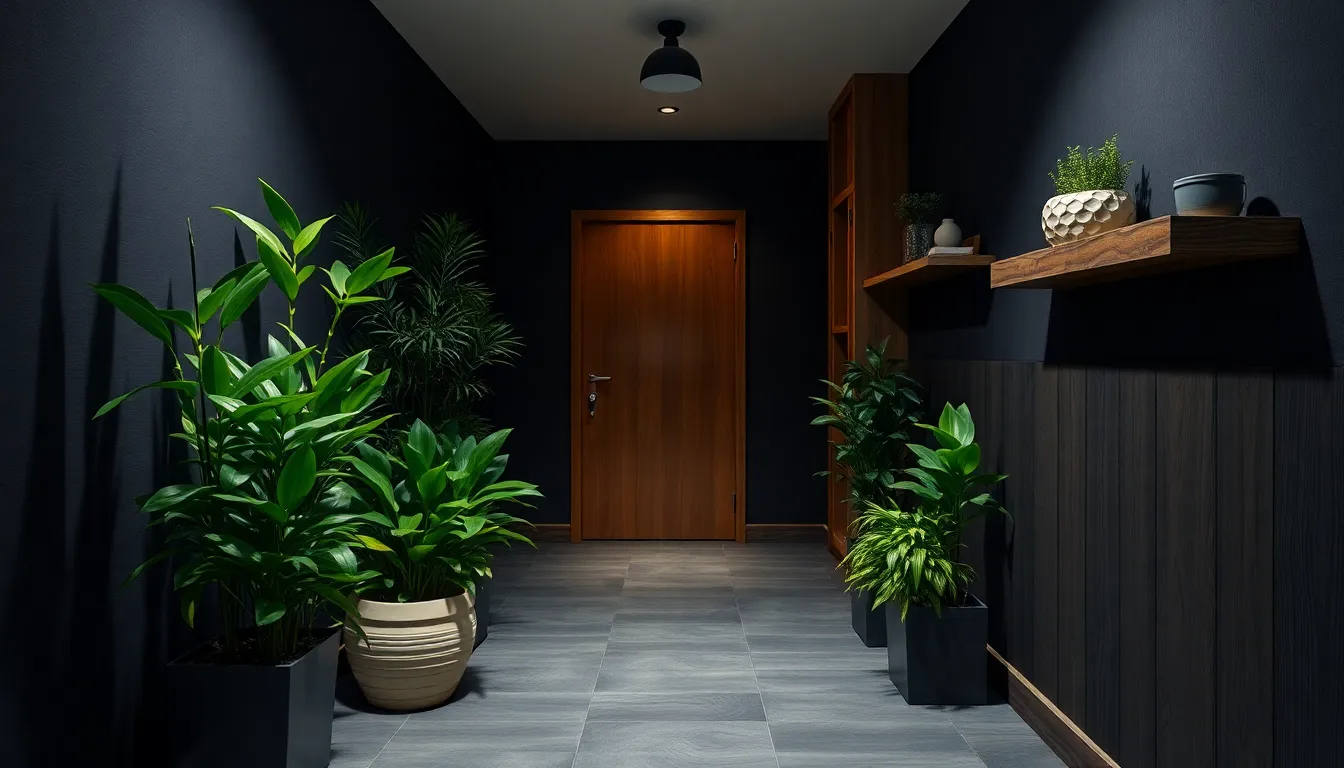
Natural elements breathe life into dark hallways, creating a striking balance between sophisticated darkness and organic warmth. We’ll explore how strategic plant placement and natural materials can transform your space into a welcoming pathway.
Low-Light Plants for Living Accents
Lucky Bamboo ‘Gold’ (Dracaena sanderiana ‘Gold’) stands out as our top choice for dark hallways, featuring vibrant green color and twisted stems that add instant life to shadowy spaces. This resilient plant thrives in low light conditions while maintaining its distinctive appearance year round.
Cast Iron Plant (Aspidistra elatior) earns its name through remarkable durability, maintaining glossy green leaves even in the darkest corners of your hallway. We recommend placing this hardy specimen in decorative planters to create focal points that complement your dark walls.
Snake Plant (Dracaena) offers unmatched tolerance for low light situations while requiring minimal maintenance from busy homeowners. Position these architectural plants in tall planters to draw the eye upward and create vertical interest in narrow spaces.
Spider Plant (Chlorophytum comosum) and Devil’s Ivy (Epipremnum aureum) excel at trailing growth patterns that soften harsh angles in dark hallways. Hang these cascading beauties from ceiling hooks or place them on high shelves to create natural curtains of greenery.
Natural Wood Elements for Warmth
Wooden paneling or flooring introduces warmth and texture that counterbalances the coolness of dark painted walls. We suggest choosing lighter wood tones like oak or maple to reflect available light while maintaining the cozy atmosphere you’ve created.
Wooden planters or shelves serve dual purposes as both decorative elements and functional storage answers in your transformed hallway. Select pieces with natural grain patterns that complement your existing metallic accents and create visual continuity throughout the space.
Reclaimed wood features bring character and sustainability to your design while adding authentic texture. Consider installing wooden accent walls or ceiling beams that echo the organic theme while providing interesting architectural details.
Stone Accessories for Organic Texture
Natural stone vases or planters add elegant touches that enhance your plant displays while introducing earthy sophistication. We recommend choosing pieces in lighter stone varieties like limestone or cream marble to reflect light and create beautiful contrasts against dark backgrounds.
Stone wall features or decorative accents bring in organic textures that complement your existing artwork and mirror arrangements. Position these elements strategically to create visual balance while maintaining the refined atmosphere you’ve established.
Stone topped side tables or consoles provide natural material contrasts that work beautifully with your metallic hardware and light colored flooring choices. These functional pieces offer storage answers while reinforcing the organic theme throughout your dark hallway transformation.
Create Cohesive Flow with Adjacent Rooms
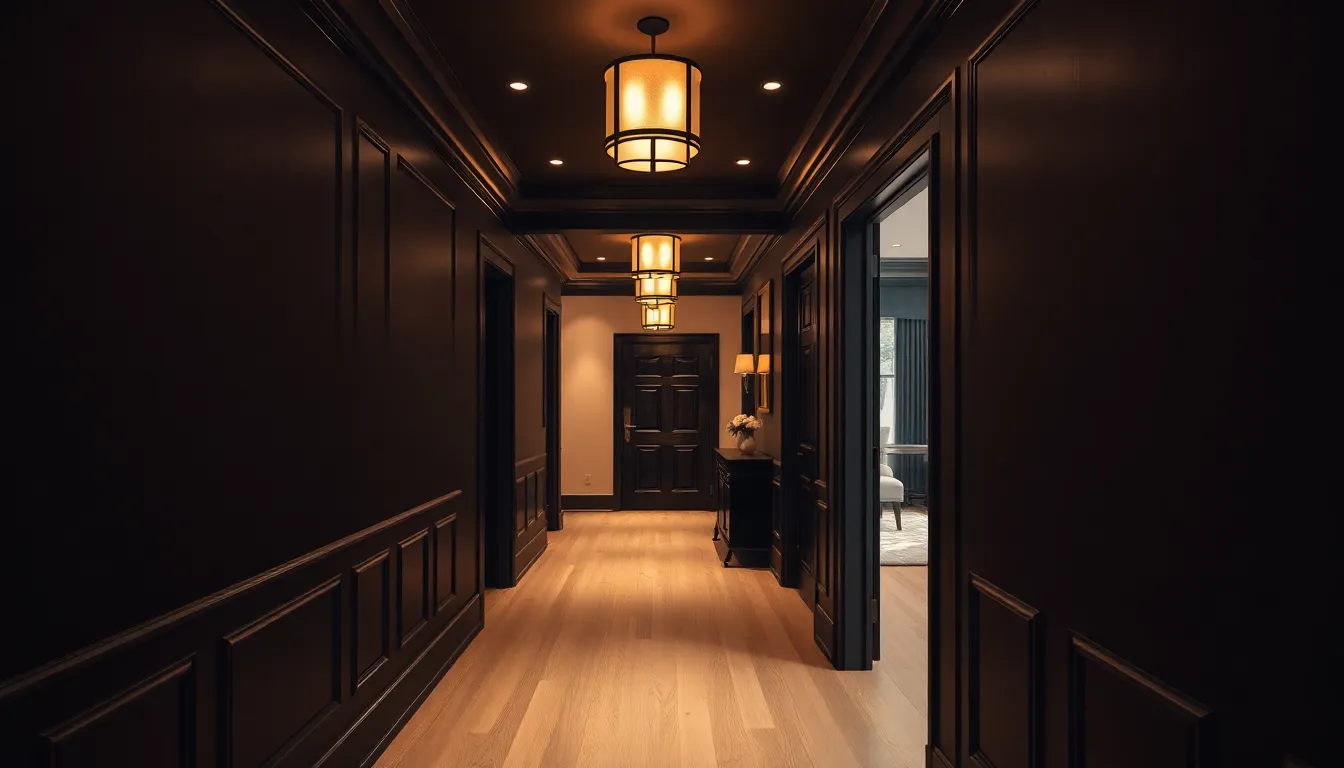
We’ll transform your dark hallway from an isolated space into a seamless extension of your home’s overall design. These strategic approaches ensure your hallway connects beautifully with surrounding rooms while maintaining its sophisticated dark aesthetic.
Transition Colors Gradually
Gradual color transitions prevent jarring visual shifts between your dark hallway and brighter adjacent spaces. We recommend starting with your darkest shade in the center of the hallway and gradually lightening the tones as you approach room entrances. Accent walls at hallway endpoints work particularly well when painted in lighter complementary colors that echo the adjacent room’s palette.
Color continuity maintains visual harmony throughout your home’s flow. We suggest using similar undertones between your dark hallway and connecting rooms, such as carrying warm charcoal tones into spaces with cream or beige walls. Ombre effects create stunning transitions when you blend colors from deep to light across wall surfaces. Paint techniques like color washing or gradient applications help achieve these smooth transitions without harsh lines.
Maintain Consistent Lighting Temperature
Consistent lighting temperature creates a unified ambiance that flows naturally from room to room. We recommend using warm toned fixtures throughout your dark hallway and adjacent spaces to establish a cohesive atmosphere. Lighting temperatures between 2700K and 3000K work best for creating cozy connections between dark hallways and living areas.
Uniform lighting styles reinforce the visual connection between spaces. We suggest choosing fixtures with similar materials or design elements, such as brass wall sconces in the hallway that complement brass table lamps in nearby rooms. Dimmer switches allow you to adjust lighting levels to match the mood and brightness of connecting spaces throughout different times of day.
Coordinate Flooring Materials
Extending the same flooring material from your dark hallway into adjacent rooms creates seamless visual continuity. We recommend continuing light colored hardwood, tile, or stone flooring to establish an uninterrupted flow that makes spaces feel larger and more connected. Large format tiles work particularly well for this purpose as they minimize grout lines and create cleaner transitions.
Transitional elements soften changes between different flooring materials when continuation isn’t possible. We suggest using coordinating area rugs or decorative mats at transition points to bridge the gap between your hallway’s flooring and adjacent room materials. Threshold strips in matching metallic finishes help create professional looking transitions while maintaining the sophisticated aesthetic of your dark hallway design.
Conclusion
Dark hallways don’t have to remain forgotten spaces in our homes. With the right combination of strategic lighting pendant fixtures wall sconces and LED strips we can transform these areas into stunning design features that rival any other room.
The key lies in embracing the darkness rather than fighting it. By incorporating light-colored flooring metallic accents and carefully positioned mirrors we create beautiful contrast that makes these spaces feel both sophisticated and inviting.
Remember that thoughtful furniture selection textured treatments and natural elements all work together to bring warmth and personality to your dark hallway. When we maintain consistent design flow with adjacent rooms we create a cohesive home environment that feels intentional and polished.
Your dark hallway is an opportunity waiting to be discovered. With these design strategies you’ll create a space that guests remember long after they leave.
Frequently Asked Questions
What are the best paint colors for dark hallways?
The most effective paint colors for dark hallways include charcoal gray for refined elegance, deep navy blue for timeless appeal, and rich black for dramatic impact. These bold dark colors create sophisticated statements and enhance the hallway’s natural ambiance rather than fighting against low light conditions.
How can I light a dark hallway effectively?
Three powerful lighting solutions work best: pendant lights for high ceilings and focal points, wall sconces for soft ambient illumination near mirrors or artwork, and LED strip lighting for flexible accent effects and safety. Strategic placement near light sources maximizes brightness and creates inviting atmospheres.
What flooring works best in dark hallways?
Light-colored flooring creates optimal contrast and reflects light effectively. Consider white or cream tiles in large formats for narrow spaces, light hardwood like oak or maple for warmth, or pale stone materials such as limestone and light marble for natural texture and light-reflecting properties.
How do metallic accents enhance dark hallways?
Metallic accents add luxury and sophistication while reflecting light. Gold hardware provides warm elegance, silver fixtures create modern brightness, and brass elements infuse vintage charm. These touches in lighting fixtures, hardware, and decorative accessories create curated, inviting atmospheres in transformed spaces.
Where should I place mirrors in dark hallways?
Position large statement mirrors to amplify light and create focal points, arrange gallery walls of small mirrors for visual interest, or use antique mirrors for character and depth. Place mirrors strategically near light sources and at intervals along hallways to maximize brightness and reflection.
What type of artwork works in dark hallways?
Light-colored paintings in neutral tones create striking contrast against dark walls while enhancing brightness. Use metallic frames to amplify sophistication and reflect light. Install proper gallery lighting with wall-mounted picture lights, LED sconces, or track lighting to showcase artwork effectively.
How can I add texture to dark hallway walls?
Consider shiplap for rustic character, wainscoting for classic appeal, or textured wallpaper for pattern interest. Paint shiplap in light tones for brightness or dark hues for coziness. Use contrasting wainscoting colors for light reflection, and choose wallpaper with metallic elements for maximum illumination.
What plants work well in dark hallways?
Low-light plants thrive in dark spaces: Lucky Bamboo, Cast Iron Plant, Snake Plant, Spider Plant, and Devil’s Ivy. These varieties add organic warmth and life while tolerating minimal light conditions. Combine with natural wood elements and stone accessories for enhanced organic themes.
How do I connect dark hallways with adjacent rooms?
Create gradual color transitions using similar undertones and ombre effects for visual harmony. Maintain consistent warm-toned lighting throughout spaces for unified ambiance. Coordinate flooring materials and use transitional elements where flooring changes to establish seamless visual continuity between spaces.

